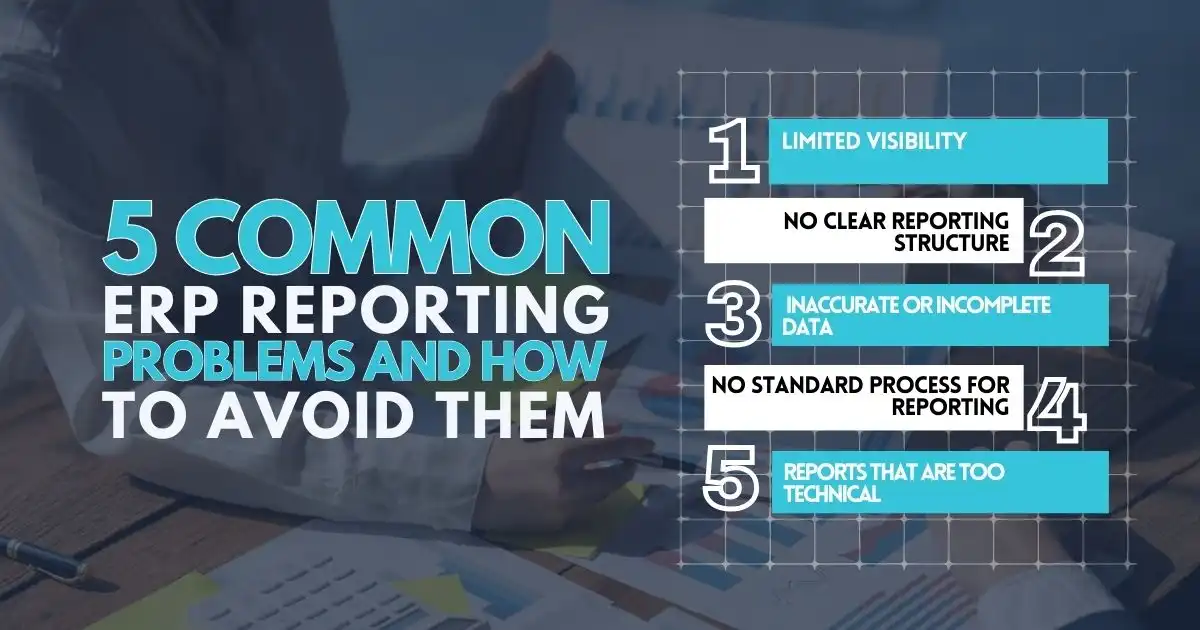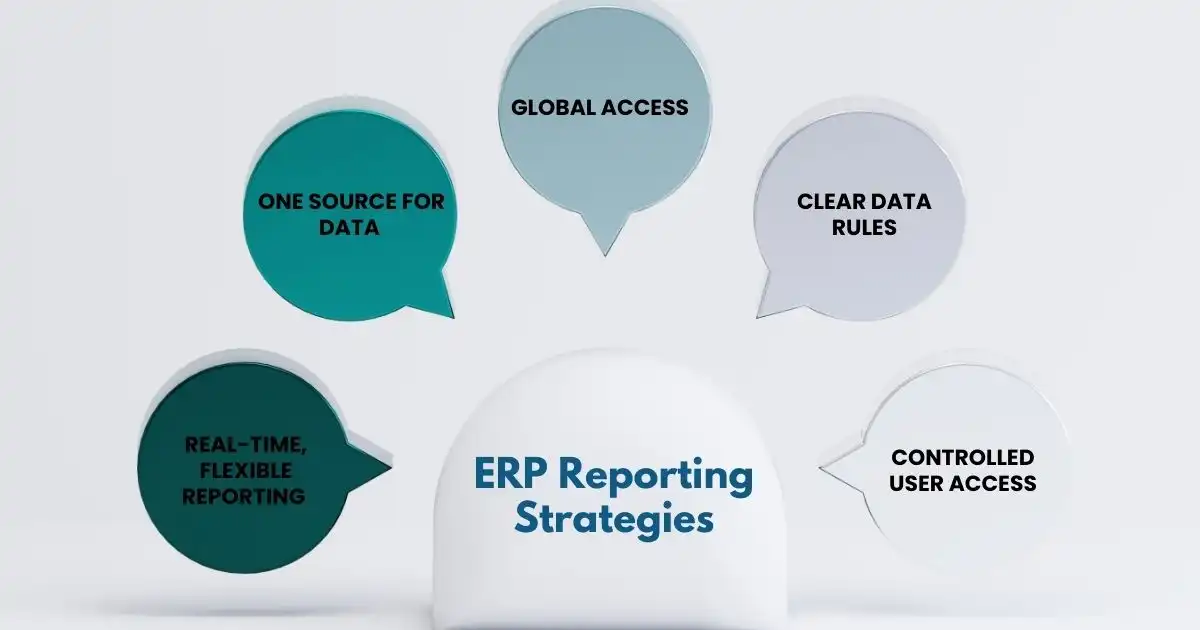Did you know that by 2025, the global ERP market is projected to reach $147.7 billion, with over 70% of large enterprises relying on ERP systems to manage their operations?
ERP systems have become essential tools for businesses aiming to streamline operations, enhance productivity, and make informed decisions. With the rapid evolution of technology and increasing business demands, the role of ERP in digital transformation is more critical than ever.
But here’s the catch: while ERP systems offer immense potential, many organizations struggle to harness their full capabilities, especially when it comes to reporting.
So, what’s the secret to unlocking the true power of your ERP system?
What Is ERP Reporting?
Enterprise Resource Planning (ERP) reporting is the process of collecting data from an organization’s ERP system and presenting it in simple, easy-to-read reports.
ERP systems gather data from different departments, such as finance, inventory, and sales. By keeping all information in one place, modern ERP systems can generate clear reports and dashboards that highlight business performance and areas that need improvement.
ERP reporting tools differ in features and complexity, but their main purpose is the same: to give decision-makers accurate information that helps improve business operations and efficiency. Reviewing these reports helps businesses follow trends and make better decisions.
These reports combine data from different parts of the ERP system and turn it into useful insights. This helps all departments understand what is happening in the business and make better decisions. For example, a company facing inventory issues can use ERP reports to view connected data from the supply chain and improve how inventory is managed.
Although ERP reporting provides useful information, it’s important to follow best practices. Relying too much on manual reporting can lead to errors. By learning how to use their ERP system properly, companies can avoid mistakes and get the most value from their data.
5 Common ERP Reporting Problems and How to Avoid Them

ERP reporting can help businesses get ahead of competitors still using manual or disconnected systems. However, it also comes with some challenges. Below are five common ERP reporting problems and tips to avoid them.
1. Limited Visibility
ERP systems are meant to give better insight into business operations, but they don’t always cover everything. If some departments aren’t fully connected to the ERP system, the data becomes incomplete or disconnected.
This can lead to inaccurate reports and poor decision-making. To avoid this, make sure every part of the business is included in the system and that there are no missing data links.
2. No Clear Reporting Structure
A reporting structure (or hierarchy) helps organize data so it makes sense. Without it, reports can be confusing or misleading.
For example, a company can group products by category before looking at individual sales numbers. This helps give context to the data. To improve accuracy and clarity, businesses should create clear rules for how data is grouped and recorded.
3. Inaccurate or Incomplete Data
Reports are only useful if the data is correct. Missing, wrong, or duplicate entries can cause serious problems. Businesses should regularly check and clean their data to fix errors early. This makes reports more reliable and helps decision-makers spot problems before they grow. Training staff and using automated tools can also help improve data quality.
4. No Standard Process for Reporting
Without clear rules on how reports are made, shared, and reviewed, teams may end up using different versions of the same report.
This creates confusion and wastes time. To avoid this, companies should set guidelines for who handles reports, how data is managed, and when reports are updated. Regular reviews can keep everyone on the same page.
5. Reports That Are Too Technical
ERP systems can handle complex data, but not everyone who reads the reports has a technical background. Business leaders often need simple, high-level summaries to make decisions. If reports are too detailed or confusing, they may be ignored or misunderstood. To fix this, reports should be easy to read and tailored to the people who will use them.
Important Parts of a Successful ERP Reporting Strategy

ERP reporting can help businesses understand how well their operations are working — but only if it’s done the right way. A strong ERP reporting strategy usually includes these seven important elements to make sure reports are accurate, useful, and delivered on time.
Accurate Data
Accurate data is the basis of all good reports. If the information is wrong, the results will be misleading and can lead to poor decisions. Businesses should regularly check their data to make sure it’s correct and up to date. This helps improve trust in the system and makes it easier to find problems and improve how things are done.
Complete Business Overview
A good reporting system should allow users to see the full picture of the business. ERP tools should offer access to different types of data — like sales, inventory, and production — so managers can understand how everything connects.
This helps with spotting what’s working, fixing what’s not, and making better long-term plans. It also supports tracking key performance indicators (KPIs), which measure progress toward business goals.
Self-Service Access
When team members can create their reports, they don’t have to wait for IT support. User-friendly dashboards and tools let employees quickly find the data they need and customize it for their specific tasks. This saves time, increases productivity, and helps the business move faster in changing situations.
One Reliable Source of Data
ERP systems gather information from many parts of the business. All this data must be stored in one place so everyone uses the same up-to-date information. This avoids confusion and makes sure all teams are working with the same facts when making decisions.
Clear Reporting Guidelines (Analytics Governance)
To make sure reporting stays useful and accurate, companies need clear rules about how reports are created and shared. This includes making sure data is organized properly and relevant to the business. Good governance also means keeping communication open between data teams and business leaders to ensure the system is supporting the company’s goals.
Planning (Implementation Roadmap)
Reporting should be planned from the start when setting up an ERP system — not added later. A roadmap helps businesses decide what reports they need, what problems might come up, and how to solve them. It keeps reporting in line with the company’s bigger ERP goals and ensures the system can handle future needs.
Flexibility
Businesses change over time, and their reporting needs do, too. ERP systems should allow for adjustments in what reports are created and how they’re used. This flexibility helps companies stay current, react to market changes, and take advantage of new opportunities. If the system is too rigid, reports can quickly become outdated or unhelpful.
ERP Reporting Strategies

ERP reporting should match your business, but these five strategies work well for most systems:
- Real-Time, Flexible Reporting – Work with live data and adjust reports as needed. Add details, change layouts, and get quick answers — ideal for fast-paced industries.
- One Source for Data – Use a single, reliable data source to avoid confusion and save time. It keeps reporting consistent and helps leaders make quicker decisions.
- Global Access – Support for multiple languages, time zones, and currencies helps teams worldwide access real-time data and work together smoothly.
- Clear Data Rules – Set guidelines for who manages data, ensure legal compliance, and regularly update these rules to keep reports accurate and secure.
- Controlled User Access – Limit data access to protect sensitive info and reduce errors. Secure remote access lets approved users get the data they need anytime.
Don’t Let Data Collect Dust
Having an ERP system is only half the battle. If your reports are buried in spreadsheets, hard to read, or always “pending IT,” you’re sitting on a gold mine you’re not digging into.
Great reporting isn’t just about tracking numbers—it’s about making moves faster, spotting trends early, and giving every team the power to act with confidence. Think of it like driving with a clear windshield vs. one covered in fog.
The right ERP reporting strategy clears the view.
So ask yourself: Is your ERP helping you lead or just keeping records?
Don’t wait for problems to knock—use your data to open doors instead. Set clear rules, keep the system clean, and give your teams the tools to ask smart questions and find their answers.
Because in today’s world, data that just sits still… goes stale.
FAQs
What is ERP reporting, and why is it important?
ERP reporting is the process of extracting, organizing, and analyzing data from your ERP system to support decision-making. It’s important because it helps businesses track performance, identify issues, and plan for growth using real-time, accurate information.
How does an enterprise reporting system differ from basic reporting tools?
An enterprise reporting system is built to handle complex, company-wide data across departments and locations. Unlike basic reporting tools, it offers deeper insights, real-time access, and custom dashboards that align with your business processes.
What makes a successful enterprise reporting strategy?
A strong enterprise reporting strategy focuses on data accuracy, accessibility, and alignment with business goals. It should include standardized definitions, real-time data sources, user access controls, and clear governance policies to ensure that reports drive informed decisions.
Which ERP reporting tools are most effective for growing businesses?
Effective ERP reporting tools for growing businesses include features like real-time dashboards, ad hoc reporting, data visualization, and mobile access. Tools such as SAP BusinessObjects, Oracle BI, and Microsoft Power BI are widely used to support detailed ERP reporting across teams.
